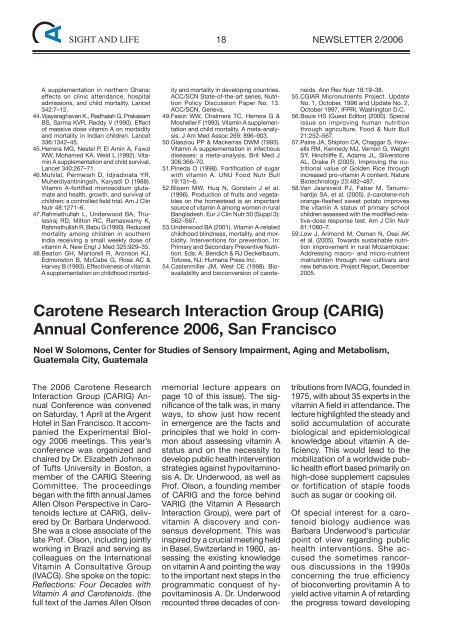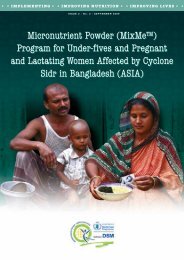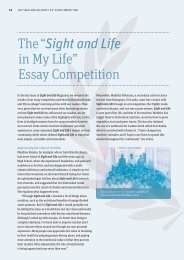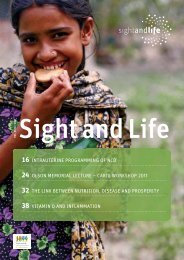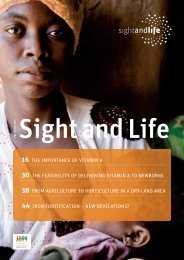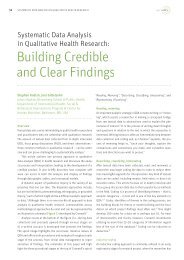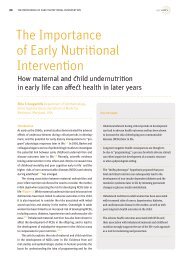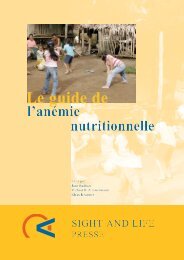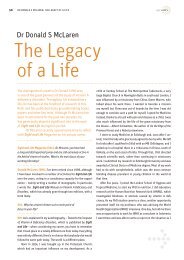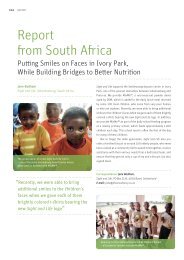Newsletter 02 2006.pdf - Sight and Life
Newsletter 02 2006.pdf - Sight and Life
Newsletter 02 2006.pdf - Sight and Life
Create successful ePaper yourself
Turn your PDF publications into a flip-book with our unique Google optimized e-Paper software.
SIGHT AND LIFE 18<br />
NEWSLETTER 2/2006<br />
A supplementation in northern Ghana:<br />
effects on clinic attendance, hospital<br />
admissions, <strong>and</strong> child mortality. Lancet<br />
342:7–12.<br />
44. Vijayaraghavan K., Radhaiah G, Prakasam<br />
BS, Sarma KVR, Reddy V (1990). Effect<br />
of massive dose vitamin A on morbidity<br />
<strong>and</strong> mortality in Indian children. Lancet<br />
336:1342–45.<br />
45. Herrera MG, Nestel P, El Amin A, Fawzi<br />
WW, Mohamed KA, Weld L (1992). Vitamin<br />
A supplementation <strong>and</strong> child survival.<br />
Lancet 340:267–71.<br />
46. Muhilal, Permeisih D, Idjradinata YR,<br />
Muherdiyantiningsih, Karyadi D (1988).<br />
Vitamin A-fortified monosodium glutamate<br />
<strong>and</strong> health, growth, <strong>and</strong> survival of<br />
children: a controlled field trial. Am J Clin<br />
Nutr 48:1271–6.<br />
47. Rahmathullah L, Underwood BA, Thulasiraj<br />
RD, Milton RC, Ramaswamy K,<br />
Rahmathullah R, Babu G (1990). Reduced<br />
mortality among children in southern<br />
India receiving a small weekly dose of<br />
vitamin A. New Engl J Med 325:929–35.<br />
48. Beaton GH, Martorell R, Aronson KJ,<br />
Edmonston B, McCabe G, Ross AC &<br />
Harvey B (1993). Effectiveness of vitamin<br />
A supplementation on childhood morbidity<br />
<strong>and</strong> mortality in developing countries.<br />
ACC/SCN State-of-the-art series, Nutrition<br />
Policy Discussion Paper No. 13.<br />
ACC/SCN, Geneva.<br />
49. Fawzi WW, Chalmers TC, Herrera G &<br />
Mosheller F (1993). Vitamin A supplementation<br />
<strong>and</strong> child mortality. A meta-analysis.<br />
J Am Med Assoc 269: 896–903.<br />
50. Glasziou PP & Mackerras DWM (1993).<br />
Vitamin A supplementation in infectious<br />
diseases: a meta-analysis. Brit Med J<br />
306:366–70.<br />
51. Pineda O (1998). Fortification of sugar<br />
with vitamin A. UNU Food Nutr Bull<br />
19:131–6.<br />
52. Bloem MW, Huq N, Gorstein J et al.<br />
(1996). Production of fruits <strong>and</strong> vegetables<br />
on the homestead is an important<br />
source of vitamin A among women in rural<br />
Bangladesh. Eur J Clin Nutr 50 (Suppl 3):<br />
S62–S67.<br />
53. Underwood BA (2001). Vitamin A-related<br />
childhood blindness, mortality, <strong>and</strong> morbidity.<br />
Interventions for prevention. In:<br />
Primary <strong>and</strong> Secondary Preventive Nutrition.<br />
Eds: A. Bendich & RJ Deckelbaum,<br />
Totowa, NJ: Humana Press Inc.<br />
54. Castenmiller JM, West CE (1998). Bioavailability<br />
<strong>and</strong> bioconversion of carotenoids.<br />
Ann Rev Nutr 18:19–38.<br />
55. CGIAR Micronutrients Project. Update<br />
No. 1, October, 1996 <strong>and</strong> Update No. 2,<br />
October 1997, IFPRI, Washington D.C.<br />
56. Bouis HS (Guest Editor) (2000). Special<br />
issue on improving human nutrition<br />
through agriculture. Food & Nutr Bull<br />
21:252–567.<br />
57. Paine JA, Shipton CA, Chaggar S, Howells<br />
RM, Kennedy MJ, Vernon G, Weight<br />
SY, Hinchliffe E, Adams JL, Silverstone<br />
AL, Drake R (2005). Improving the nutritional<br />
value of Golden Rice through<br />
increased pro-vitamin A content. Nature<br />
Biotechnology 23:482–487.<br />
58. Van Jaarsveid PJ, Faber M, Tanumihardjo<br />
SA, et al. (2005). β-carotene-rich<br />
orange-fleshed sweet potato improves<br />
the vitamin A status of primary school<br />
children assessed with the modified-relative-dose<br />
response test. Am J Clin Nutr<br />
81:1080–7.<br />
59. Low J, Arimond M, Osman N, Osei AK<br />
et al. (2005). Towards sustainable nutrition<br />
improvement in rural Mozambique:<br />
Addressing macro- <strong>and</strong> micro-nutrient<br />
malnutrition through new cultivars <strong>and</strong><br />
new behaviors. Project Report, December<br />
2005.<br />
Carotene Research Interaction Group (CARIG)<br />
Annual Conference 2006, San Francisco<br />
Noel W Solomons, Center for Studies of Sensory Impairment, Aging <strong>and</strong> Metabolism,<br />
Guatemala City, Guatemala<br />
The 2006 Carotene Research<br />
Interaction Group (CARIG) Annual<br />
Conference was convened<br />
on Saturday, 1 April at the Argent<br />
Hotel in San Francisco. It accompanied<br />
the Experimental Biology<br />
2006 meetings. This year’s<br />
conference was organized <strong>and</strong><br />
chaired by Dr. Elizabeth Johnson<br />
of Tufts University in Boston, a<br />
member of the CARIG Steering<br />
Committee. The proceedings<br />
began with the fifth annual James<br />
Allen Olson Perspective in Carotenoids<br />
lecture at CARIG, delivered<br />
by Dr. Barbara Underwood.<br />
She was a close associate of the<br />
late Prof. Olson, including jointly<br />
working in Brazil <strong>and</strong> serving as<br />
colleagues on the International<br />
Vitamin A Consultative Group<br />
(IVACG). She spoke on the topic:<br />
Reflections: Four Decades with<br />
Vitamin A <strong>and</strong> Carotenoids. (the<br />
full text of the James Allen Olson<br />
memorial lecture appears on<br />
page 10 of this issue). The significance<br />
of the talk was, in many<br />
ways, to show just how recent<br />
in emergence are the facts <strong>and</strong><br />
principles that we hold in common<br />
about assessing vitamin A<br />
status <strong>and</strong> on the necessity to<br />
develop public health intervention<br />
strategies against hypovitaminosis<br />
A. Dr. Underwood, as well as<br />
Prof. Olson, a founding member<br />
of CARIG <strong>and</strong> the force behind<br />
VARIG (the Vitamin A Research<br />
Interaction Group), were part of<br />
vitamin A discovery <strong>and</strong> consensus<br />
development. This was<br />
inspired by a crucial meeting held<br />
in Basel, Switzerl<strong>and</strong> in 1960, assessing<br />
the existing knowledge<br />
on vitamin A <strong>and</strong> pointing the way<br />
to the important next steps in the<br />
programmatic conquest of hypovitaminosis<br />
A. Dr. Underwood<br />
recounted three decades of contributions<br />
from IVACG, founded in<br />
1975, with about 35 experts in the<br />
vitamin A field in attendance. The<br />
lecture highlighted the steady <strong>and</strong><br />
solid accumulation of accurate<br />
biological <strong>and</strong> epidemiological<br />
knowledge about vitamin A deficiency.<br />
This would lead to the<br />
mobilization of a worldwide public<br />
health effort based primarily on<br />
high-dose supplement capsules<br />
or fortification of staple foods<br />
such as sugar or cooking oil.<br />
Of special interest for a carotenoid<br />
biology audience was<br />
Barbara Underwood’s particular<br />
point of view regarding public<br />
health interventions. She accused<br />
the sometimes rancorous<br />
discussions in the 1990s<br />
concerning the true efficiency<br />
of bioconverting provitamin A to<br />
yield active vitamin A of retarding<br />
the progress toward developing


